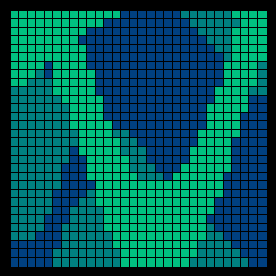How to Homogenize the ELF Reservoir Data
The following describes how to use the JHomogenizer tool to homogenize a map
comprised of porous media data first proposed by ELF researchers. The map has
three distinct permeability values as shown in the figure below. The main flow
path is a finger that runs from the lower middle portion of the domain to the
upper right hand corner of the domain.

The following describes how to create a 6x6 grid of homogenized values from the
original 30x30 grid of original heterogeneous values. This means solving a total
of 36 local problems using the homogenization methods.
The Steps:
In this example the steps for creating a coarser grid from an original
heterogeneous map defined on a finer grid. In addition, an example of how to
create an html file containing the output is presented.
- If the JHomogenizer interface is not running, start up the interface.
- The map can be loaded into the JHomogenizer interface or clicking on the
Load Map or the Import Map buttons. Then load in the map
from the elfmap.map file. This file comes along with the JHomogenizer
tool and can be found in the data set. The data set can also be
downloaded the link above.
- The next step is to set the homogenized grid size. The values in the
Homog Input text fields. The values in the x and y coordinate
boxes should be changed to 6. The heterogeneous input boxes should show
30, 30, and 1. Thus the homogenization problems will each be defined on
a 5 by 5 grid.
- The next step is to choose a homogenization methods in the list and click
in the item. The item should be highlighted.
- Finally, click on the Homogenize! button. The interface will start
the calculations and the status will be shown in the Status: line
near the bottom of the interface. You will be prompted for a map name for
the result of the homogenization process. Enter the name in the dialog
and type a carriage return or click on the Okay button.
- You can display the values by clicking on the map in the map list and
then you click on Display Values button. The values will be
displayed in the text window. The values from the HomCode choice should
be the those shown on the ELF Reservoir Data
web page.
- Once this is done, other methods can be applied to the initial map by
clicking on the map in the map list. In our example, click on invertedL.
Then click on another homogenization method choice and finally click on
the Homogenize! button. To display the new values, click on the
Display Values button.
We can also create an output image of the map using the MapEditor tool.
To do this do the following.
- Start up the MapEditor tool.
- Once the map is loaded into the display area, click on the Create PPM
File. The interface will write a ppm file that contains an image of
the map. The name of the file is map.ppm.
- The ppm file can easily be translated into other graphics formats using
xview or other image editing software.
Finally, you can save the map data and all of the homogenized results by
clicking on the Save Maps button. The data will be stored in a folder
with the same name as the name of the file. All of the homogenized results will
be stored in subfolders of the original folder.
To reload the data you can use the instructions in some of the other examples.
These instructions will not be repeated here.
Creating HTML Output:
A facility in the MapEditor tool allows the user to create a web version of the
data in a map file. This can be done as follows:
- If the JHomogenizer interface is not running, start up the interface.
- The map can be loaded into the JHomogenizer interface or clicking on the
Load Map or the Import Map buttons. Then load in the map
from the elfmap.map file. This file comes along with the JHomogenizer
tool and can be found as described above.
- Open the MapEditor tool by clicking on the Show MapEditor button.
The ELF Reservoir data should appear.
- Click on the Create HTML File button in the MapEditor tool. A file
named map.html will be created in the same folder where the elfdata.map
file resides.
The output file can be viewed immediately using most any browser. In addition,
the file can be edited into other web pages as desired.

